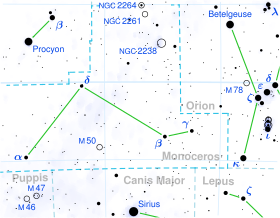| Observation data Epoch J2000.0 Equinox J2000.0 | |
|---|---|
| Constellation | Monoceros |
| Right ascension | 06h 37m 24.04130s[1] |
| Declination | +06° 08′ 07.3719″[1] |
| Apparent magnitude (V) | 6.06[2] |
| Characteristics | |
| Spectral type | O8I + O7.5III[3] |
| U−B color index | –0.88[2] |
| B−V color index | +0.05[2] |
| Astrometry | |
| Radial velocity (Rv) | +24.5[4] km/s |
| Proper motion (μ) | RA: –2.73[1] mas/yr Dec.: +0.31[1] mas/yr |
| Distance | 5,245 ly (1,608[5] pc) |
| Details | |
| A | |
| Mass | 54[6] M☉ |
| Radius | 14.2[6] R☉ |
| Luminosity | 224,000[6] L☉ |
| Surface gravity (log g) | 3.5 ± 0.1[6] cgs |
| Temperature | 33,500 ± 2,000[6] K |
| Rotational velocity (v sin i) | 75[7] km/s |
| B | |
| Mass | 56[6] M☉ |
| Radius | 10.8[6] R☉ |
| Luminosity | 123,000[6] L☉ |
| Surface gravity (log g) | 3.5 ± 0.1[6] cgs |
| Temperature | 33,000 ± 2,000[6] K |
| Rotational velocity (v sin i) | 300[7] km/s |
| Other designations | |
| Database references | |
| SIMBAD | data |
Plaskett's Star /ˈplæskɪts/, also known as HR 2422 and V640 Monocerotis, is a spectroscopic binary at a distance of around 6600 light-years. It is one of the most massive binary stars known, with a total mass of around one hundred times that of the Sun.[6] Indeed, it was long thought to be the most massive known binary system,[7][8] but evidence collected between 1996 and 2005 demonstrated that Eta Carinae, which was previously thought to be a massive individual star, is a binary system.[9]
This system is named after John Stanley Plaskett, the Canadian astronomer who discovered its binary nature in 1922. Plaskett was assisted in his observations by his son, Harry Hemley Plaskett. The pair of stars have a combined visual magnitude of 6.05, and are located in the constellation of Monoceros.

The orbital period for the pair is 14.39625±0.00095 d.[6] The secondary is a rapid rotator with a projected rotational velocity of 300 km·s−1,[7] giving it a pronounced equatorial bulge.[6]
The brightness varies irregularly from 6.0 to 6.1 on a timescale of a few hours, thought to be due to many factors including the binary orbit, hot spots in the colliding winds, and granulation.[3] The luminosities of each component are much lower than expected for their spectral types. It has been suggested that the star may be twice as far away as assumed, not a member of the Monoceros OB2 association, and each component would be about four times as luminous as currently calculated.[citation needed] The masses derived from the binary orbit are also somewhat higher than expected from the spectral types, but with considerable uncertainty due to assumptions about the inclination.[3]
- ^ a b c d Cite error: The named reference
aaa474_2_653was invoked but never defined (see the help page). - ^ a b c Cite error: The named reference
clpl4_99was invoked but never defined (see the help page). - ^ a b c Mahy, L.; Gosset, E.; Baudin, F.; Rauw, G.; Godart, M.; Morel, T.; Degroote, P.; Aerts, C.; Blomme, R.; Cuypers, J.; Noels, A.; Michel, E.; Baglin, A.; Auvergne, M.; Catala, C.; Samadi, R. (2010). "Plaskett's star: Analysis of the CoRoT photometric data". Astronomy & Astrophysics. 525: A101. arXiv:1010.4959. Bibcode:2011A&A...525A.101M. doi:10.1051/0004-6361/201014777. S2CID 30687338.
- ^ Cite error: The named reference
gcsrvwas invoked but never defined (see the help page). - ^ Cite error: The named reference
aaa507_2_833was invoked but never defined (see the help page). - ^ a b c d e f g h i j k l m Cite error: The named reference
aaa489_2_713was invoked but never defined (see the help page). - ^ a b c d Cite error: The named reference
aaa525_101was invoked but never defined (see the help page). - ^ Ley, Willy (August 1965). "The Galactic Giants". For Your Information. Galaxy Science Fiction. pp. 130–142.
- ^ Cite error: The named reference
apj633_1_L37was invoked but never defined (see the help page). - ^ Cite error: The named reference
MASTwas invoked but never defined (see the help page).
